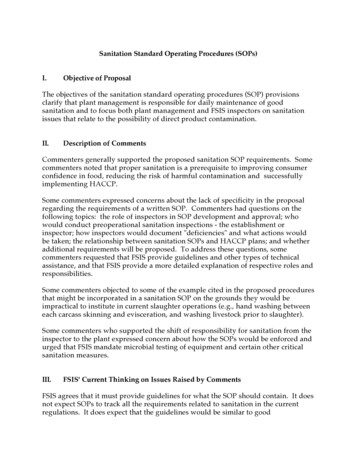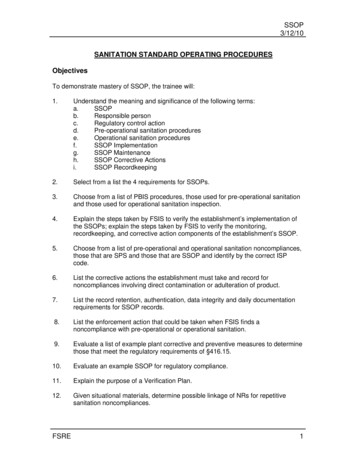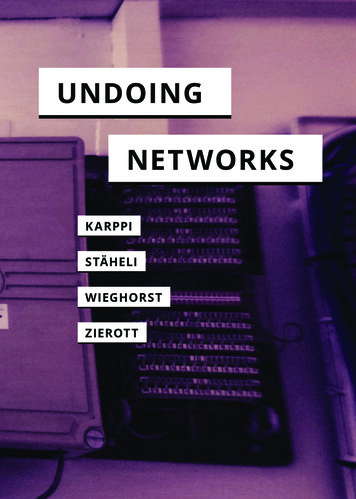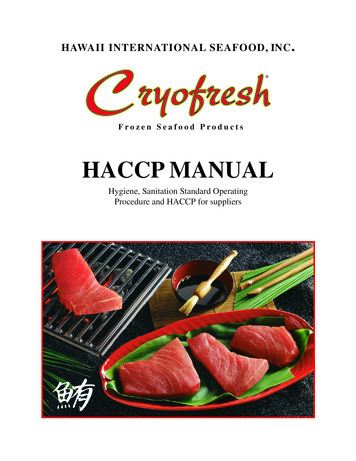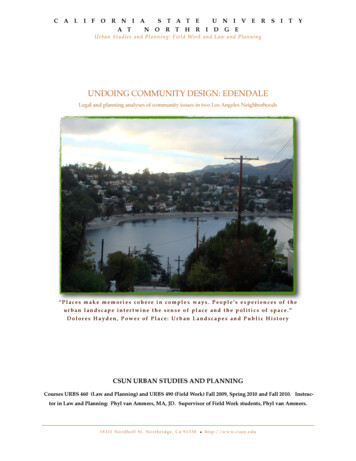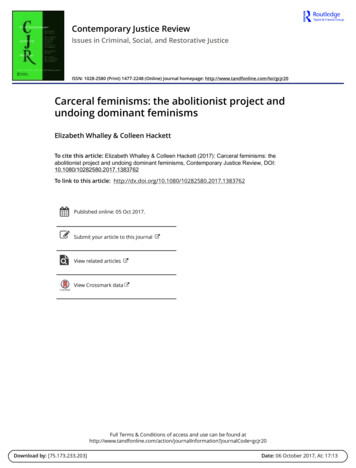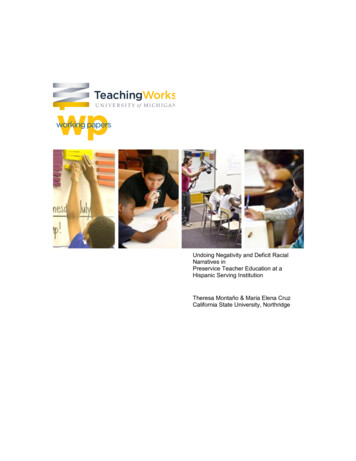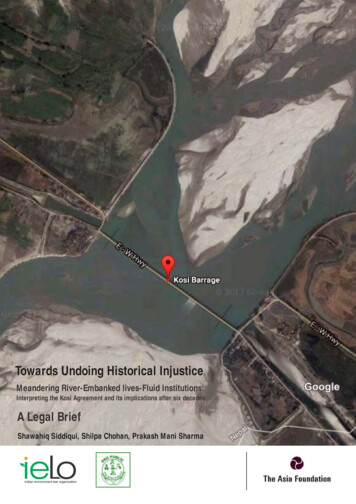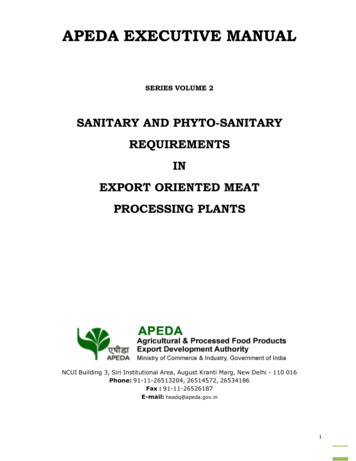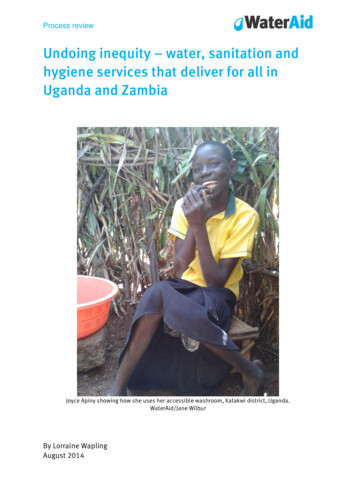
Transcription
Process reviewUndoing inequity – water, sanitation andhygiene services that deliver for all inUganda and ZambiaJoyce Apiny showing how she uses her accessible washroom, Katakwi district, Uganda.WaterAid/Jane WilburBy Lorraine WaplingAugust 2014
Process reviewContentsAcronyms and abbreviations . 3Executive summary . 4Section 1 Summary of key findings . 6Section 2 Background . 92.1 Methodology . 10Section 3 Main findings. 123.1 The inclusive WASH approach . 123.1.1 What is inclusive WASH? . 133.1.2 Implementing an inclusive WASH approach . 153.1.3 Positive benefits from an inclusive WASH approach . 173.2 Capacity development . 203.3 Understanding and ownership . 24Section 4 Learning from the research process . 294.1 Process-monitoring tools and data analysis . 304.1.1 Tools 1 & 2 – the inclusive WASH process and monitoring participation . 324.1.2 Tool 3 – Participation ladder . 354.1.3 Tool 4 – Partner equity and inclusion capacity assessment . 374.1.4 Tools 5 to 8 – successes and challenges with inclusive WASH, the mostsignificant changes and capturing the costs . 40Section 5 Costing the inclusive WASH approach . 41Section 6 Forward-looking recommendations . 436.1 Specific recommendations from the process monitoring . 45Appendix 1 Key informants . 47Appendix 2 Documents reviewed . 48References . 502
Process reviewAcronyms and DOUNICEFWASHWEDAWEDCWHOAppropriate technology centre (Uganda)Community-led total sanitationUN Convention on the Rights of Persons with DisabilitiesDevelopment aid from people to people (Zambia)Disabled people's organisationLeonard Cheshire DisabilityLeonard Cheshire Inclusive Development CentreRainwater harvestingSanitation and Hygiene Applied Research for EquityChurch of Uganda, Teso District Development OrganisationUnited Nations Children’s FundWater, sanitation and hygieneWera Development Agency (Uganda)Water, Engineering Development Centre (UK)World Health Organization3
Process reviewExecutive summaryWaterAid has been undertaking a collaborative research project called ‘UndoingInequity – water, sanitation and hygiene services that deliver for all in Uganda andZambia’. The aims of the project are to try to understand the barriers andopportunities disabled, chronically sick and older people face to accessing water,sanitation and hygiene (WASH) services; to develop and test an inclusive WASHapproach that addresses the barriers; and to assess the impact that improvedaccess to safe WASH has on the lives of these vulnerable people. Partly funded bySanitation and Hygiene Applied Research for Equity (SHARE), this research projectrunning from January 2012 to December 2014 is part of a wider equity andinclusion programme which has been developing in WaterAid since 2010.The purpose of this review was to examine the strengths and weaknesses of theemerging approach to inclusive WASH that has been developed in Uganda andZambia, and to make recommendations for how this might be scaled up acrossWaterAid.The review shows very strong evidence that WaterAid staff in Uganda and Zambiaare approaching inclusive WASH as a process rather than as a specific project – atleast in principle. Staff are aware that inclusion applies to everything they do,although for this to become embedded across their programmes will take time.WaterAid partners have taken longer than WaterAid staff to adopt inclusiveprinciples, and to varying degrees still regard inclusive activities to be specificallylinked to environmental access for disabled people. Nevertheless, evidenceindicates that partners realise that inclusion is applicable to all areas ofdevelopment, even if they cannot yet confidently operationalise this.Because of the participatory nature of the Undoing Inequity project, and, inparticular, its more recent emphasis on researching the process, there is now ahigh degree of ownership of the inclusive WASH process in Uganda and Zambia. Asmentioned, the idea of inclusion being applicable to all development is wellunderstood, and WaterAid staff and partners are keen to continue and expand thework.Some of the key concepts associated with inclusive WASH – such as disability,rights-based approach and social inclusion – have proved difficult to introduce,especially to partners and communities. WaterAid underestimated the amount ofsupport and training people needed at the beginning of the project, and thereforesome of the early interventions were not exactly inclusive; rather, the interventionstended to focus on finding hardware-based solutions to physical access. Althoughthese solutions are very important, and can be a very good way to raise the profileof the right to accessible WASH, it obviously removed focus from meaningful4
Process reviewparticipation in decision-making. It is now much clearer that concepts such asparticipation and rights are highly innovative for many people and that WaterAidand partner staff involved in this project need ongoing support to develop the skillsnecessary to apply the inclusive WASH approach.The review showed clearly that WaterAid is in a unique position to bridge the gapbetween the social inclusion sector and the water, sanitation and hygiene sector.WaterAid is developing a very practical and effective inclusive WASH approach,which is highly replicable. With increasing evidence for the effectiveness ofinclusive WASH, WaterAid has the opportunity to advocate widely for it to beadopted across the sector. WaterAid is also working well with the social inclusionsector, which traditionally has not paid much attention to WASH issues. Advocacythat combines messages from both sectors could have an important impact on thepost-2015 Sustainable Development Goal discussions.5
Process reviewSection 1Summary of key findingsThis brief review has enabled identification of several interesting observations andlearning opportunities with respect to WaterAid’s evolving inclusive WASHapproach. A consistent ‘inclusive WASH’ approach is being applied at country levelIn Uganda and Zambia programmes and partners are implementing a series ofactions including increased numbers of vulnerable people into WASH activities(see Figure 1). Both programmes appreciate the need for an initial baseline orcontext review as part of a process to identify who faces exclusion fromdevelopment. Sensitisation of communities to issues around rights and inclusionfollows, along with a mobilisation process that seeks to identify vulnerableindividuals living in the target communities. Work then focuses on ensuring thatmeetings, training sessions and planning forums involve these individuals, andthat they have the opportunity to express their needs and contribute to decisionmaking. Last, different accessible WASH facilities are discussed and developed,with monitoring and support provided as people learn how to create and maintainnew designs. Programme staff and partners now feel ownership of inclusive WASHAs a result of the mentoring, training and support provided to Uganda and Zambiaby WaterAid UK, WEDC and local partners such as ATC, staff and partners in bothcountries now perceive inclusive WASH as a process. Although it has been hard forpartners and staff to realise that what they have been involved in was not a discreetproject, they are now at a point at which they can appreciate that the work is achange in the way WASH is delivered. New working norms are being established,and these are beginning to affect whole organisations. There is still some way to goto fully embed the approach, and if individual staff leave it might be affected, butan increasing number of people are now involved (community members and theirleaders, tradespeople, government representatives, and partner and programmestaff) and so demand is increasing. Inclusive WASH improves the way organisations engage with communitiesand improves interactions within communitiesSome interesting benefits have emerged from the review of the inclusive approach.One is that WaterAid programmes have become much more aware of their partners’capacity to facilitate community-led development. When partners were put underpressure to mobilise a diverse range of people to participate in inclusive WASHactivities, their shortage of facilitation skills became clear. A series of training andmentoring activities were initiated to improve this engagement, which haveincreased capacity – not only for WASH activities, but also for other programmes.This training has also started to improve the ways communities organise6
Process reviewthemselves and respond to different needs. With closer attention to ensuring awide range of people are represented in planning and decision-making,communities are becoming much more aware of the range of issues and solutions.Positive changes in attitudes towards vulnerable people are also occurring aspeople are enabled to show their value. Key concepts such as rights, inclusion, disability and vulnerability need tobe constantly reinforced because they represent a shift in perception ofdevelopment problemsOne of the most difficult aspects of applying an inclusive WASH approach has beenthe definition of its principles in practical terms. Although programme staff showeda more consistent understanding of key concepts, they were not as confident attransferring that knowledge to partners. In turn, partners found these new ways ofapproaching problems unfamiliar and perhaps, for them, without precedent. Whennew concepts like this emerge new vocabulary is needed to reinforce the ideas andensure actions can be replicated in different contexts. One of the problems withintroducing the new approaches has been little attention to ensuring key principlesand concepts are defined in local languages, and ensuring reference materials areavailable for the early stages of implementation. Communities are highlyunpredictable in their response to awareness-raising and sensitisation aroundinclusion, and can raise very demanding questions as they struggle with thechange in standard. Those tasked with introducing the new ways of thinking haveto be very confident in their own knowledge and, although confidence doesincrease with experience, this is initially very hard. Costing inclusive WASH is very complex and risks creating disincentives ifthe language used is too negativeOne clear learning point from this review is that WaterAid is unlikely to be able toget definitive information about the cost of inclusion. In a sense, focusing on costwithout being able to establish the value of the outcomes (ie, to calculate costbenefits) might be counterproductive, simply highlighting that inclusive processes‘cost more’. Perhaps a better way to phrase this is to say: ‘this is the cost of aninclusive process’. Because WaterAid has no intention of not being inclusive, in thefuture it will need to ensure that the language it uses to refer to the process ispositive. To refer to ‘extra’ or ‘additional’ costs risks reinforcing the idea thatinclusion is optional rather than integral. Accessibility audits with vulnerable and non-vulnerable people together area powerful tool in the inclusive WASH processAlthough accessibility audits were only carried out on a small scale in Zambia, theeffect was profound. They were one of the most powerful tools for changingattitudes and for highlighting the need for practical change. The experience peoplegained from observing first-hand how difficult it was to access standard WASH7
Process reviewfacilities led to immediate calls for change. It also gave vulnerable people anopportunity not only to express their challenges but also to show they had valuableinsights to contribute to discussions. Whether accessibility audits could become astandard part of the inclusive WASH approach is worth considering. WaterAid has a unique opportunity to bridge the gap between the socialinclusion sector and the WASH sector with its inclusive approachThe review clearly showed that WaterAid has developed an approach which iswidely applicable to the WASH sector. The actions necessary to improve theparticipation of a wide range of people in WASH decision-making are not radicallydifferent from the norm, and can be integrated into approaches such as CommunityLed Total Sanitation (CLTS) if there is organisational ‘will’ or ‘buy-in’. WaterAid isbeginning to show that this integration can be achieved. In reaching out to a morediverse range of people, WaterAid has connected with the social inclusion sector –such as agencies working with vulnerable people, for example disability NGOs,Disabled People’s Organisations and those representing older people. Thisengagement has highlighted the fact that these agencies rarely consider WASH tobe part of their programme work and yet it is fundamental to the way people areable to live their lives. By working with both sectors WaterAid has identified asignificant gap in the social inclusion process. Paying attention to how peopleaccess WASH actions highlights many of the deprivations and the discriminationthat some people face. Efforts to improve this situation lead not only to a betterstandard of living but also to changes in attitude.8
Process reviewSection 2BackgroundWaterAid has been undertaking a collaborative research project called ‘UndoingInequity – water, sanitation and hygiene services that deliver for all in Uganda andZambia’. The aims of the project are to try to understand the barriers andopportunities disabled, chronically sick and older people face to WASH services; todevelop and test an inclusive WASH approach that addresses the barriers; and toassess the impact that improved access to safe WASH has on the lives of thesevulnerable people. Partly funded by Sanitation and Hygiene Applied Research forEquity (SHARE), this research project running from January 2012 to December 2014is part of a wider equity and inclusion programme which has been developing inWaterAid since 2010.As part of the collaboration WaterAid has been working with the Water, Engineeringand Development Centre (WEDC), and Leonard Cheshire Inclusive DevelopmentCentre (LCIDC). The Institute of Economic and Social Research (University ofZambia) and the Appropriate Technology Centre (ATC) in Uganda are researchpartners who did the baseline and mid-term review data collection. At the countrylevel, WaterAid programmes have been working with their partners (DevelopmentAid from People to People in Zambia; Wera Development Agency and Church ofUganda Teso District Development Organisation in Uganda) to implement, monitorand document inclusive WASH.It is important to recognise that the inclusive WASH approach reviewed in thisstudy developed organically within WaterAid over several years in response to localdemands and international rights frameworks. Since its establishment in 1981,WaterAid has tried to address equity issues by focusing its work in some of theleast developed countries in Africa and Asia, and by working with communities andpeople who are marginalised.1 As an organisation, WaterAid made a commitmentto promoting a more proactive equity and inclusion agenda in their Global Strategy(2009–2015) which states as a key value that their work should be inclusive:‘WaterAid aims to be inclusive in all that we do.’2The first aim of the Global Strategy is to ‘promote and secure poor people’s rightsand access to safe water, improved hygiene and sanitation’, which recognises thatsome marginalised and vulnerable people lack access to WASH services and canbe excluded from decision-making processes.In order to operationalise the aim and value, WaterAid developed a comprehensiveEquity and Inclusion Framework (2010) based on 18 months of consultations withprogrammes, partners and key external stakeholders, aiming to provide a‘common, coherent and pragmatic understanding of equity and inclusion’ andestablish a set of ‘minimum standards and indicators to make sure we are9
Process revieweffective’.3 Without being prescriptive, this framework sets out to define the basicprinciples of equity, inclusion and the rights-based approach, and describes howthese can be applied in practice and how the results can be monitored andmeasured.Although not explicitly stated, the idea behind the framework follows a ‘twin-track’approach4 – to work to ensure that all WaterAid programmes are ‘broadly inclusive’while recognising that ‘(S)ome work will also focus on approaches designed toreach specific marginalised groups’.5 The framework also identifies that it is notonly project activities that need to address equity and inclusion, but that WaterAidalso needs to develop the capacity of partners to adopt this approach and work onits own internal systems to ensure staff are not excluded from recruitment andretention.This framework has developed within an international environment in which thereis growing appreciation that issues of exclusion, vulnerability and inequality areinextricably linked to chronic poverty.6 For specific groups such as disabled people,the past few years have seen a far greater focus from mainstream developmentagencies on the effects of their exclusion from the development process as a resultof international frameworks such as the UN Convention on the Rights of Personswith Disabilities7 and key reports such as WHO’s World Report on Disability8 andUNICEF’s State of the World’s Children 2013 report focused on disability.9 It hasbeen evident since 2010 that the Millennium Development Goals will not beachievable without the inclusion of disabled people,10 which was most recentlyaffirmed by statements within the High-Level Panel report into the post-2015agenda that recommended future frameworks should ‘leave no onebehind regardless of ethnicity, gender, geography, disability, race or otherstatus’.112.1MethodologyAs part of the overall process monitoring research work, this review aimed to:assess the strengths and weaknesses of the approach to implementing inclusiveWASH; look at the approach used in process monitoring; and assess the prospectsto mainstream it within WaterAid. Specifically, the approach will address: The ‘Inclusive WASH approach’, including the collaborative process ofdevelopment and implementation. Capacity development mechanisms and the impact on staff skills,understanding, awareness and attitudes for more inclusive and accessibleprogramming. The extent to which staff and partners implementing the programmeunderstand and own the inclusive approach to WASH.10
Process review Process monitoring tools developed and the data generated fromadministering the tools. Challenges related to costing the inclusive WASH approach. Forward-looking recommendations about how to improve the approach andmainstream it within WaterAid’s work.This review was done using a document review and key informant interviews. 17people were interviewed, via Skype, representing WaterAid staff from the UK,Zambia and Uganda; partner staff from Zambia and Uganda; and the WEDC andATC.12 Appendix 2 contains a full list of documents reviewed.11
Process reviewSection 33.1Main findingsThe inclusive WASH approachSince 2010 WaterAid programmes have been piloting equity and inclusion work tovarying degrees, but what became evident from several programme reviews wasthat this work often took the form of projects that directly targeted disabledpeople;13 general barriers were not being systematically identified andinterventions were not being designed around social model principles.14 In 2011WaterAid, in collaboration with its SHARE consortium partners15 and LeonardCheshire Disability’s Cross-Cutting Disability Research Programme, broughttogether 22 researchers and policy makers with experience in WASH, disability andequity for a roundtable discussion on current knowledge and practice regardingaccess to WASH for disabled people. The resulting briefing paper highlighted thefact that disabled people are rarely prioritised in WASH interventions and aresubject to environmental, institutional and attitudinal barriers that prevent theirparticipation.16 However, small-scale interventions were generating evidence forwhat types of issues are key for inclusion and how the needs of disabled peoplecan be built into project designs. The problem was that such small-scale findingswere not being used systematically to inform the sector about the most effectiveapproaches to inclusion.The Undoing Inequity projectAs a result, WaterAid put together a collaborative research project withWEDC and LCIDC to investigate and document how to increase theinclusivity of WASH programmes. Under the research project entitled‘Undoing inequity: inclusive water, sanitation and hygiene programmes thatdeliver for all’, WaterAid has been researching and documenting a practicalapproach aimed at improving access to WASH. Two country programmes,Uganda and Zambia, have been working with their partners (DevelopmentAid from People to People in Zambia, Wera Development Agency, andChurch of Uganda Teso District Development Organisation in Uganda) toimplement, monitor and document the approach, while in the UK they havebeen supporting and collating the evidence to draw lessons applicable tothe whole organisation.The research was based on the premise that both countries were alreadyimplementing some form of inclusive WASH activities mostly limited to addressingphysical barriers, but would be supported to develop and carry out the processmonitoring activities associated with the research.17 This premise assumed that12
Process reviewprogramme and partner staff were familiar with the principles of equity andinclusion and had the capacity to run inclusive interventions. Although the originalresearch proposal did include a budget for additional activities, such as staff timeand design of accessible WASH facilities, these activities were not included in thefinal donor contract because of a shortfall in funding.18The inclusive approach described in the research protocol19 is not an explicit seriesof actions, although it does cover elements of what programmes have beenimplementing.20 Interestingly, it does not refer to WaterAid’s Equity and InclusionFramework. The approach in the protocol suggests: developing the capacity ofpractitioners to design inclusive WASH interventions; conducting and analysingbaseline information on the barriers faced by vulnerable people to accessingstandard WASH facilities; mobilising communities to include everyone in activities;providing accessible information around sanitation and hygiene; locating andconstructing facilities that are accessible and appropriate for different sections ofthe community; ensuring water user committees are representative of marginalisedpeople; and ensuring that tariff options are developed that are sensitive to theeconomic situation of the poorest people.21 Additionally, the protocol mentionsthat water technologies, both new and rehabilitated, should be designed to reduceany physical barriers and that community-led total sanitation (CLTS) projectsshould continue as planned but ensuring that barrier analysis is carried out andinterventions are designed with the needs of everyone included.3.1.1 What is inclusive WASH?Overall WaterAid staff and partners strongly agreed that inclusive WASH involvesraising awareness around barriers to access and ensuring a greater range ofcommunity members participate in discussion and decision-making forums. Atpartner level, however, there did seem to be more of a focus on work specificallywith disabled people (or individuals with mobility problems, which could includeolder or chronically sick people). This result shows that, although broadlyunderstood, inclusive WASH is not yet being consistently defined between partnersand WaterAid programmes.WaterAid country programme staff defined inclusive WASH as:“ making sure all people are targeted We have to make sureeveryone is attending meetings.”“It’s an approach that ensures all groups of people participate.”“ means addressing the needs of different users . It’s alsoabout ensuring participation.”13
Process review“ Before we implemented this approach the participation ofmarginalised people was really low. Now they are participating inmuch greater numbers. Their participation is important.”WaterAid staff from Uganda and ZambiaWEDA showing inclusive design options to community members, in Amuria, Uganda.WaterAid/Jane WilburWhat came across quite strongly from their explanations was that staff andpartners regarded inclusion as a process. The first step was to sensitisecommunities to the fact that different people have different needs and to ensureeveryone has the opportunity to voice their needs. Examples included hiringinterpreters for deaf people, or helping older people or those with mobilityproblems to attend meetings. Second was to ensure any facilities that are built orimproved are accessible for all – for example, changing designs to accommodatewheelchairs, or altering pump handles to make them easier to use. Sometimesthese improvements involve working directly with people to find out what solutionsare the most practical, and testing them out.14
Process reviewWaterAid partners were slightly less consistent or confident in defining inclusiveWASH. In Uganda they reported:“ it brings together people with different needs. For example inour WASH that means disabled, chronically sick.”“ equal opportunities for disabled people. Inclusion of disabledpeople and normal people.”Programme partners, UgandaHere, both partners focused on the needs of individuals – specifically in this casedisabled and chronically sick people, although the partners also recognised thatolder people often fell into one or both of these groups. The use of the term ‘normalpeople’ juxtaposed with disabled people is not uncommon in countries likeUganda, and is most likely to be used in place of the term ‘non-disabled’; however,this highlights an important issue around concepts and language. There might notbe a local language translation for the term non-disabled, and therefore theconcept itself could be hard to understand. When terms like normal people areused, it is always worth investigating whether people have the language toconceptualise and describe disability in social-based or rights-based terms.In Zambia the partners reported:“Inclusive WASH is where all marginalised people incommunities are included and benefit from project activities We hear about what they need, what works for them and theyhear from us about how things can be designed differently.”“Actually, inclusion is more like an approach where we doactivities which include disabled people.”Programme partner staff, ZambiaIn Zambia too, disabled people were mentioned most frequently as being the targetof an inclusive approach, and there was again emphasis on working withindividuals to design facilities that better serve their physical needs.3.1.2 Implementing an inclusive WASH approachPerceptions around what inclusive WASH means also affected how WASH was putinto practice, although the process was described quite consistently. BothWaterAid programmes described carrying out sensitisation and mobilisationprocesses to encourage greater awareness around access and ensure more people15
Process revieware identified and included in decision-making. Both programmes made use ofbarrier analysis to identify where the gaps were and as a way to start discussionsaround how access issues could be resolved. Both programmes collaborated withlocal tradespeople and community members to design, test and implementphysically accessible facilities.22Participatory barrier analysis at the Monze district level, Zambia.WaterAid/Jane Wilbur.On the basis of discussions with partner and programme staff, six elements makeup WaterAid’s inclusive WASH in practice (Figure eranalysisBaseline /contextanalysisFigure 1: WaterAid's inclusive WASH approach16SupportingcapacityInclusivesolutions andactions
Process reviewWEDC and ATC have been especially important in the later stages of the approach,providing invaluable capacity-building support to partners on the design ofaccessible facilities. Although communities do offer solutions, these are oftenquite small in scope. Partners also had litt
WaterAid has been undertaking a collaborative research project called ‘Undoing Inequity – water, sanitation and hygiene services that deliver for all in Uganda and Zambia’. The aims of the project are to try to understand the barriers and opportunities disabled, c
